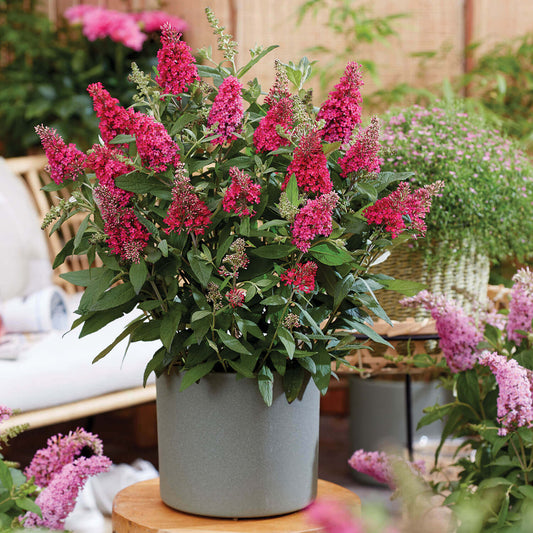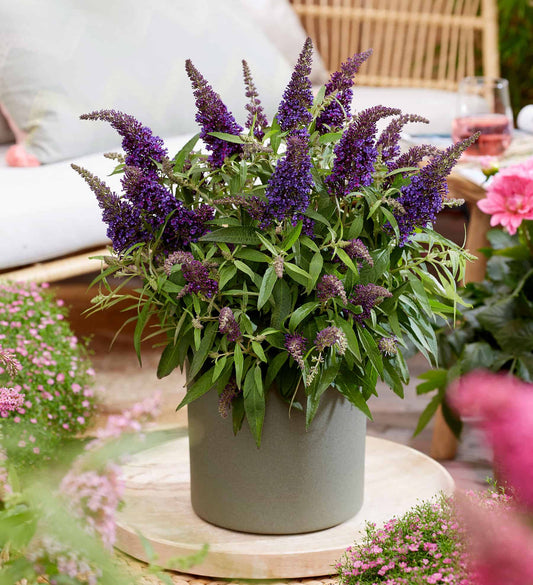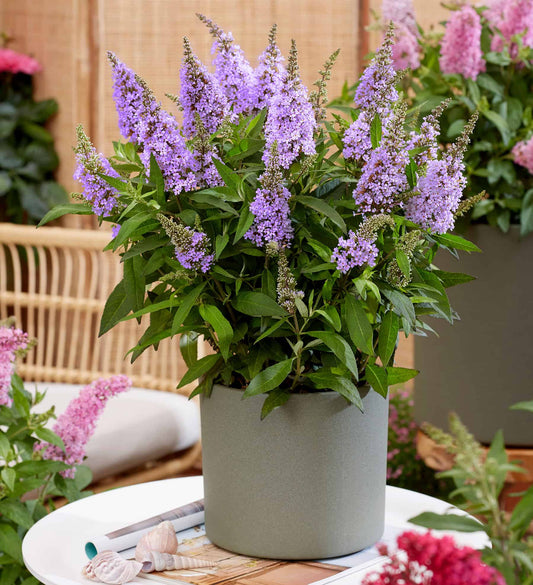How to Prepare Your Butterfly Candy Bush for Winter in the Snow Belt
Butterfly Candy butterfly bushes are compact, beautiful, and magnetically attractive to pollinators. But in Snow Belt climates, where winters bring deep snow, repeated freeze–thaw cycles, and prolonged cold, you’ll want to take a few extra precautions to help the plant survive and bounce back strong in spring.
The good news? With a little preparation, your Butterfly Candy bushes can overwinter successfully and return even stronger in spring. Here’s your complete guide to help it thrive through the frost:
1. Skip the Fall Pruning
One of the biggest mistakes gardeners make is cutting back their Butterfly Candy too early. Butterfly bushes bloom on new wood, meaning the growth of the current season. Heavily pruning in fall or early winter can remove the stems that would produce next year’s flowers.
Instead, leave the stems standing through winter. The old stalks provide a bit of insulation and help protect the crown and root zone from wind and snow. Once spring arrives and you see new shoots emerging, prune back the previous year’s wood to about 6–12 inches.
2. Apply Mulch to Protect the Roots
Mulching is one of the most effective tools for overwintering perennials in cold climates. It acts as a blanket, helping to moderate soil temperature and protect the root zone from freeze–thaw injury.
After the ground has frozen (or after the first hard freeze), apply a 2–4 inch layer of organic mulch, like shredded bark, pine straw, chopped leaves, around the base of the plant. Leave a small gap between mulch and the crown to avoid trapping moisture against the base, which can lead to rot.
3. Provide Wind & Snow Protection (If Needed)
In harsh Snow Belt environments, especially for young (1–2 years old) or less-established plants, the combination of ice, heavy snow, and drying winter winds can cause damage beyond what mulch can handle.
USDA Zones 5 and colder are especially at risk. If your climate experiences freeze–thaw cycles, high wind exposure, or heavy snow accumulation, your butterfly bushes will likely need a bit of extra overwintering care.
If this applies to you, consider using burlap or breathable frost cloth to gently wrap the plant, protecting it from windburn and frost damage. Be sure it’s loose enough to allow airflow and not press against the stems. Support stakes or a simple frame may help the plant keep its shape under snow load.
In container settings, move the pot to a more sheltered spot (e.g., close to a house foundation or behind a windbreak). You can also “bury” the pot partially in the ground as extra insulation. Some gardeners do this in very cold zones by digging a hole and set the potted plant (pot and all) into the ground in fall for extra protection, then lift it out again in spring.
4. Monitor Moisture & Drainage
Even in winter, plants can suffer if their roots are either waterlogged or too dry. Proper drainage and moisture balance are important going into and coming out of dormancy.
Before the ground freezes, give your plant a deep soak so the root zone is well hydrated. After freeze-up, avoid heavy watering and water only if there’s an extended thaw and the soil can absorb water (but be careful not to leave plants in standing water). It's also a good idea to check that your planting site has good drainage. Sites that hold water or are soggy in the spring will increase the risk of root disease.
5. Spring Recovery: What to Expect
When winter begins to let up and spring approaches, keep an eye out for new growth emerging from your butterfly bushes. Once you spot new growth and the risk of frost has passed, trim back the dead wood, shape the plant, and remove old stems. This is also a good time to refresh the mulch layer. Just be careful to avoid piling it too heavily on new shoots.
You should also take this time to check for signs of waterlogging, pests, or disease as the plant wakes up. As long as everything looks good, consider a light application of fertilizer once buds are actively growing to support new growth and flowering!
Remember, don’t panic if your plant looks dead above ground!
In colder regions, Butterfly Candy may die back to the ground, especially after a harsh winter. This is normal! Butterfly bushes often regrow from the rootstock, even if the top growth doesn’t survive. Be patient and give the plant a few extra weeks in spring to wake up before deciding whether to replace it!
Final Tips & Reminders
- Don’t rush pruning; waiting until spring protects your Butterfly Candy's flowering potential.
- Use wind protection or frost cloth in exposed sites or when temperatures will dip extremely low.
- Be extra careful with container-grown plants. They lose heat faster and may require more protection or relocation!
- Understand your local microclimate. If your garden is on a hill, exposed plateau, or in a cold pocket, you may need to increase your winter protection.
- Patience is key! If the top of your butterfly bush looks dead by spring, wait until mid-spring to assess whether the rootstock is alive before replanting or replacing.
With attentive care and some foresight, your Butterfly Candy bushes can make it through even the toughest Snow Belt winters and come back strong, ready to bloom and delight another season!
Want to learn more? Click here for additional planting and care tips, or sign up for our email newsletter today to receive expert care tips, planting guides, and garden inspiration!






